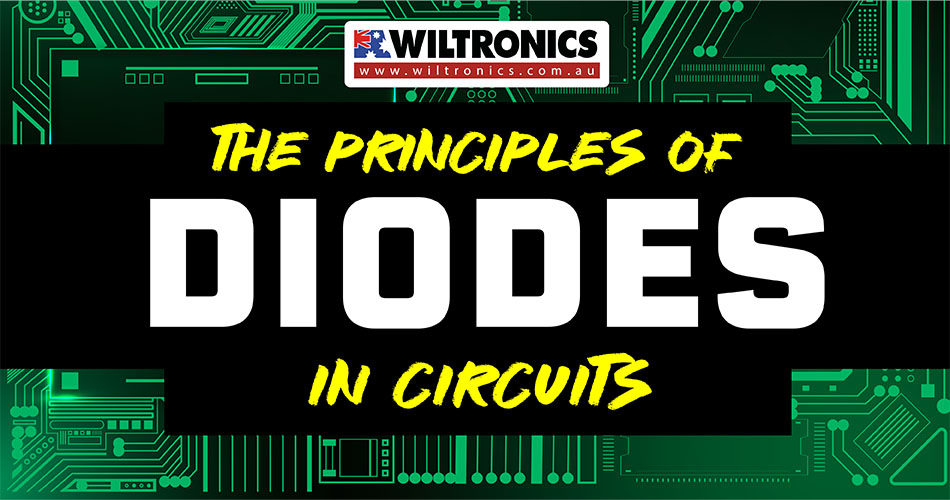The Working Principles of Diodes in Circuits
April 10, 2023

Have you ever wondered how electronic devices, such as your smartphone, work? A crucial component is a diode, which controls the flow of electricity in circuits. This guide will explore the working principles of diodes in circuits, so keep reading!
What Is a Diode?
A diode is a semiconductor device that allows current to flow in only one direction. It has two terminals, an anode and a cathode, which are marked with a plus (+) and minus (-) sign, respectively.
When a voltage is applied to the anode, the diode conducts current and allows it to flow through to the cathode. However, the case is different if the voltage is applied in the opposite direction. In most cases, the diode will not conduct and will block the current flow.
When a diode allows current flow, it is forward-biased. In contrast, when a diode is reverse-biased, a diode acts as an insulator and does not permit current to flow. Overall, a diode essentially acts as a one-way switch for a current.
This makes diodes useful in a variety of electronic circuits. Take rectifiers, voltage regulators, and signal modulators, for example.
Diodes in Circuits: How Do They Work?
Diodes in circuits mostly regulate electricity flow and maintain a constant voltage. In some cases, they also extract signals from radio waves.
Diodes, in general, allow current to flow in only one direction. In more technical terms, they work by having a p-n junction. This is a boundary between two materials with different electrical properties.
The p-n junction becomes conductive and allows current to flow when forward-biased. Alternatively, it becomes non-conductive when it is reverse-biased. This property makes diodes useful in circuits for rectifying AC into DC, for instance.
Not only are diodes a fundamental component in electronics, they also play an important role in ensuring proper circuit operation.
The Role of Diodes in Circuits
Below are the common uses of diodes:
1. Rectification
Rectification refers to the process of converting AC to DC. It ensures the devices receive a steady and reliable source of power.
Its role in ‘diodes in circuits’ is only the forward current extracted from the (AC). This occurrence is known as the rectifying action of the diode.
2. Signal demodulation
Diodes are also used in signal demodulation. This is the process of extracting the original signal from a modulated signal.
Take radio communication, for example. Diodes are used to demodulate the signal from the radio waves. This allows the original audio signal to be heard.
3. Voltage regulation
Diodes can also be used to regulate voltage in a circuit. A Zener diode, for example, can be used to maintain a constant voltage level in a circuit.
What happens when the voltage exceeds a certain level? The Zener diode conducts and regulates the voltage to the desired level.
4. Protection
Diodes can also be used to protect circuits from overvoltage and reverse voltage. To do so, place a diode in series with a circuit. This can prevent current from flowing in the wrong direction. In return, it protects the circuit from damage.
5. Light emission
Light-emitting diodes (LEDs) are another important use of diodes. LEDs are used in everything from displays to lighting systems. They also are an important use of diodes. They work by converting electrical energy into light energy.
As technology continues to advance, the use of diodes in circuits will continue to expand.
Types of Diodes
Here are some of the different types of diodes and their uses:
Schottky diodes
Schottky diodes are used for high-speed switching applications. They have a low forward voltage drop and a fast switching speed. They are ideal in power converters, voltage clamps, and low-voltage power supplies.
Rectifier diodes
Rectifier diodes are used to convert AC power to DC power. They have a single PN junction and allow current to flow in only one direction. They are commonly used in power supplies and battery chargers.
Zener diodes
Zener diodes are used as voltage regulators. They have a reverse breakdown voltage for consistency across a circuit. They are commonly used in voltage regulators, surge protectors, and wave shapers.
Switching diodes
This diode opens and closes a circuit, such as a switch. It turns ON when voltage is applied in the direction of power flow. And when voltage is applied in the reverse direction, it turns OFF.
The Bottom Line
Diodes have a positive and negative end, playing an important role in circuits. Take when the current flows in the correct direction, for example. In this case, the diode allows it to pass through with very little resistance. This is useful for voltage regulation and rectification.
Another is when the current flows in the opposite direction. When this happens, the diode blocks it altogether. This protects circuits from reverse voltage and prevents damage to components.
Additionally, diodes can be used in conjunction with other components. These include capacitors and resistors. When paired, they can create more complex circuits.
© Electrotech Brands Pty Ltd 2023


Write a Comment
You must be logged in to post a comment.